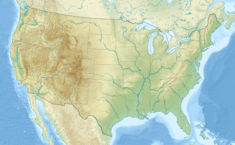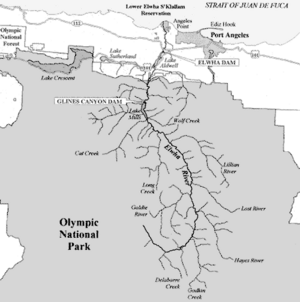Glines Canyon Dam facts for kids
Quick facts for kids Glines Canyon Dam |
|
|---|---|

Glines Canyon Dam
|
|
|
Location of Glines Canyon Dam in Washington #USA
|
|
| Location | On Elwha River, along Olympic Hot Springs Road, about 11 miles (18 km) southwest of Port Angeles, in Olympic National Park, Clallam County, Washington, USA |
| Coordinates | 48°00′07″N 123°36′00″W / 48.00203°N 123.59991°W |
| Construction began | 1925 |
| Opening date | 1927 |
| Demolition date | 2014 |
| Dam and spillways | |
| Impounds | Elwha River |
| Height | 210 ft (64 m) |
| Reservoir | |
| Creates | Lake Mills |
| Total capacity | 40,500 acre⋅ft (50,000,000 m3) |
| Surface area | 415 acres (168 ha) |
| Power station | |
| Installed capacity | 13.3 MW |
|
Glines Canyon Hydroelectric Power Plant
|
|
| Area | 7 acres (2.8 ha) |
| Architectural style | Classical Revival |
| MPS | Hydroelectric Power Plants in Washington State, 1890--1938 MPS |
| NRHP reference No. | 88002742 |
| Added to NRHP | December 15, 1988 |
The Glines Canyon Dam, also known as the Upper Elwha Dam, was a large concrete dam built in 1927. It stood 210 feet (64 meters) tall on the Elwha River inside Olympic National Park in Clallam County, Washington.
This dam was about 13 miles (21 km) upriver from where the Elwha River meets the ocean. It created a lake called Lake Mills. However, the dam was taken down in 2014. This was part of a big project to bring the Elwha River back to its natural state. It was the tallest dam ever removed on purpose.
Contents
History of the Dam
The Glines Canyon Dam was built by a private company. Its main job was to make electricity. This power helped factories and military bases on the Olympic Peninsula. These included lumber and paper mills in Port Angeles.
In 1988, the Glines Canyon Hydroelectric Power Plant was listed on the National Register of Historic Places. This area included the dam itself, the powerhouse, and the system that carried water. It was recognized for its historical importance.
How the Dam Affected River Life
The Glines Canyon Dam did not have a way for fish to pass through it. This meant that salmon and other fish could not swim upstream to lay their eggs. The dam blocked access to about 38 miles (61 km) of the main river habitat. It also blocked over 30 miles (48 km) of smaller streams.
Before the dam, the Elwha River had huge numbers of salmon. More than 400,000 adult salmon used to return each year. They would swim in over 70 miles (113 km) of river habitat. By the early 2000s, fewer than 4,000 adult salmon returned every year. The dam greatly reduced their numbers.
Restoring the Elwha River
Many groups worked hard to convince the government to remove the two dams on the Elwha River. They wanted to restore the river and its valley to their natural state. In 1992, a law was passed called the Elwha River Ecosystem and Fisheries Restoration Act. This law allowed the U.S. Federal Government to buy the Glines Canyon Dam and another dam downstream. The plan was to remove them to help the river's ecosystem.
The Elwha Ecosystem Restoration project began in September 2011. Work started with removing the Elwha Dam, which was downstream. The very last part of the Glines Canyon Dam was taken out on August 26, 2014. Now that the dam is gone, the area that was once Lake Mills is being replanted with trees and plants. The riverbanks are also being made stronger to stop erosion. This helps the natural environment recover faster.
Images for kids








